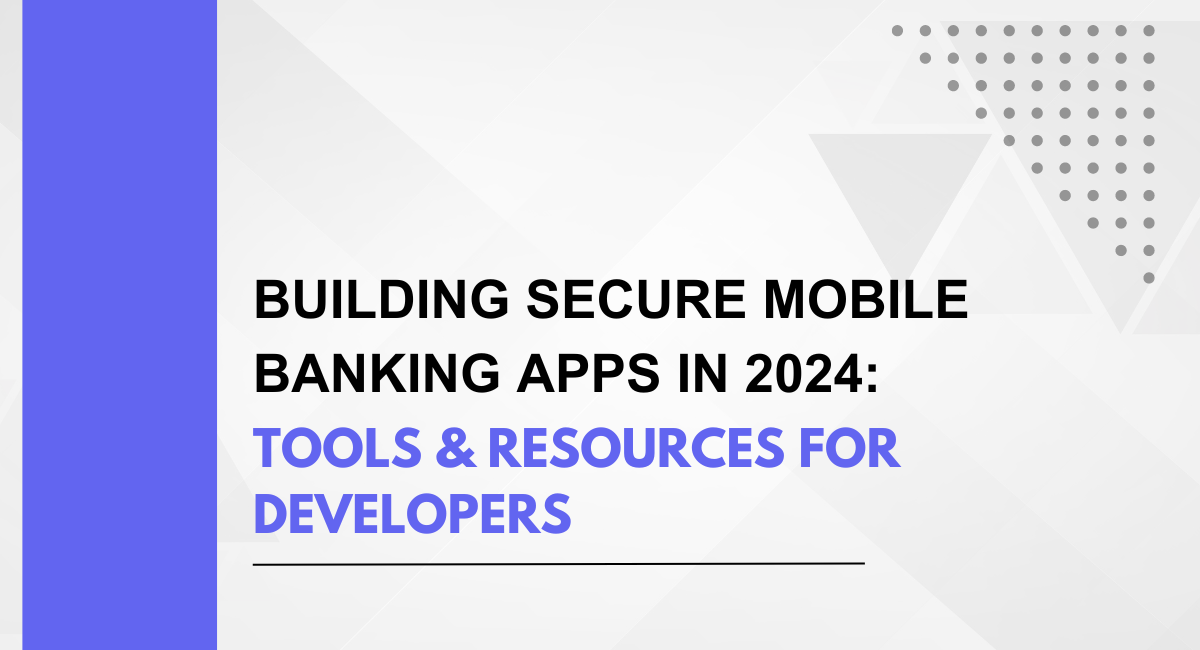Forget Fort Knox – your smartphone is now the guardian of your financial fortress. But with great convenience comes great responsibility, especially for developers building secure mobile banking apps in 2024. "Adventure is the life of commerce, but caution is the life of banking," says Walter Bagehot, author of Lombard Street: A Description of the Money Market.
Cybercriminals are craftier than ever, so how do you stay ahead of the curve? We'll unveil the essential tools and resources to build bank-vaults in your pocket, empowering users and thwarting digital foes. From cutting-edge encryption to battle-tested authentication, this guide will equip you to construct mobile banking apps that are both user-friendly and fortress-strong.
Mobile banking apps have emerged as indispensable tools for managing finances on the go. However, with the convenience comes the crucial concern of security. The importance of robust security measures in mobile banking apps cannot be overstated.
These applications deal with sensitive financial information, making them lucrative targets for cybercriminals. A breach in security could lead to dire consequences, including identity theft, financial fraud, and compromised user trust. Therefore, ensuring the highest level of security in mobile banking apps is paramount to safeguarding users' assets and maintaining the integrity of financial institutions.
The Mobile Banking Market, valued at USD 6.91 billion in 2021, is set to increase from USD 7.72 billion in 2022 to USD 18.7 billion by 2030, with a projected Compound Annual Growth Rate (CAGR) of 11.7% during the forecast period from 2023 to 2030.
Threat Landscape

Mobile banking apps face a myriad of security threats that can compromise users' sensitive financial information. Among the most prevalent threats are malware attacks, where malicious software infiltrates devices to steal login credentials or perform unauthorized transactions.
Phishing scams are another common threat, where fraudsters use deceptive messages to trick users into revealing their personal or financial information. Additionally, man-in-the-middle attacks occur when hackers intercept communication between the user's device and the banking server, allowing them to eavesdrop on sensitive data.
Trends and Emerging Threats
As technology evolves, so too do the tactics employed by cybercriminals. Recent trends in mobile banking security threats include the rise of mobile ransomware, which encrypts users' files and demands payment for decryption.
Another emerging threat is SIM swapping, where attackers hijack a user's phone number to intercept authentication codes and gain unauthorized access to their accounts. Moreover, with the increasing adoption of biometric authentication, there are concerns about the potential vulnerabilities in biometric data storage and authentication processes.
Security Breaches in Mobile Banking Apps
Several high-profile security breaches in mobile banking apps serve as cautionary tales for both developers and users. One notable case involved a banking app that suffered a data breach, exposing millions of users' personal and financial information to hackers.
Another incident saw a mobile banking app targeted by malware, resulting in unauthorized transactions and financial losses for users. These case studies highlight the real-world consequences of security vulnerabilities in mobile banking apps and underscore the importance of implementing robust security measures to protect against such breaches.
Secure Mobile Banking App Development
Implementing secure authentication mechanisms is paramount in ensuring the integrity of mobile banking apps. Developers should incorporate multifactor authentication, biometric authentication, or strong password policies to verify users' identities and prevent unauthorized access to accounts.
Data Encryption and Protection
Data encryption is essential for safeguarding sensitive information transmitted and stored within mobile banking apps. Utilizing robust encryption algorithms ensures that user data remains unreadable to unauthorized parties, thereby minimizing the risk of data breaches and unauthorized access.
Secure Communication Protocols
Employing secure communication protocols such as HTTPS (Hypertext Transfer Protocol Secure) is critical for protecting data transmitted between the user's device and the banking server. By encrypting communication channels, developers can prevent interception and eavesdropping by malicious actors.
Secure Storage of Sensitive Information
Developers must adhere to strict guidelines for securely storing sensitive information such as login credentials, account numbers, and transaction details. Utilizing secure storage mechanisms, such as encrypted databases or secure key management systems, helps mitigate the risk of data theft or unauthorized access.
Compliance with Regulatory Standards
Adhering to regulatory standards such as the General Data Protection Regulation (GDPR) and the California Consumer Privacy Act (CCPA) is imperative for mobile banking app developers. Compliance with these regulations ensures that user privacy rights are protected, and sensitive data is handled in accordance with legal requirements, thereby fostering trust and transparency with users.
Tools for Secure Mobile Banking App Development

Mobile App Security Testing Tools
Static Analysis Tools:
Static analysis tools scan the source code of mobile banking apps to identify potential security vulnerabilities without executing the code. These tools analyze code syntax, structure, and dependencies to uncover common security flaws such as insecure coding practices or vulnerabilities in third-party libraries.
Dynamic Analysis Tools:
Dynamic analysis tools assess the behavior of mobile banking apps in real-time by executing them in controlled environments. These tools monitor app interactions, network traffic, and system resources to detect runtime vulnerabilities such as improper data handling or insecure communication protocols.
Penetration Testing Tools:
Penetration testing tools simulate cyber attacks on mobile banking apps to identify weaknesses in their security defenses. Ethical hackers use these tools to exploit vulnerabilities and assess the app's resilience against various attack scenarios, helping developers identify and remediate potential security risks.
Encryption Libraries and Frameworks
Encryption libraries and frameworks provide developers with tools to implement robust encryption algorithms and protocols in mobile banking apps. These libraries offer features such as data encryption, decryption, key management, and secure storage, ensuring that sensitive information remains protected from unauthorized access or interception.
Secure Authentication Libraries and SDKs
Secure authentication libraries and software development kits (SDKs) offer pre-built components and APIs for implementing secure authentication mechanisms in mobile banking apps. These libraries support features such as multifactor authentication, biometric authentication, OAuth, and OpenID Connect, enhancing the app's resistance to unauthorized access and identity theft.
Secure Communication Libraries
Secure communication libraries enable developers to establish secure channels for transmitting data between the mobile banking app and backend servers. These libraries implement encryption protocols such as SSL/TLS to encrypt data in transit, preventing interception or tampering by malicious actors during communication sessions.
Compliance and Regulatory Tools
Compliance and regulatory tools assist developers in ensuring that mobile banking apps adhere to legal requirements and industry standards such as GDPR, CCPA, PCI DSS, and ISO 27001. These tools provide guidelines, checklists, and automated checks to verify compliance with data protection regulations, privacy policies, and security best practices.
Incorporating these tools into the mobile banking app development process enhances security posture, mitigates risks, and demonstrates a commitment to protecting users' sensitive financial information. By leveraging these resources, developers can build mobile banking apps that inspire trust, comply with regulations, and withstand the ever-evolving threat landscape of cyber threats.
Best Practices for Secure Mobile Banking App Development
Regular Security Audits and Assessments
Conducting regular security audits and assessments is essential for identifying and addressing vulnerabilities in mobile banking apps. By performing comprehensive reviews of code, configurations, and infrastructure, developers can proactively detect security weaknesses and implement necessary remediation measures to protect against potential threats.
Implementing Multi-factor Authentication
Multi-factor authentication adds an extra layer of security by requiring users to verify their identity using multiple factors such as passwords, biometrics, or one-time codes. By implementing multi-factor authentication in mobile banking apps, developers can significantly reduce the risk of unauthorized access and enhance user authentication security.
Utilizing Tokenization for Sensitive Data
Tokenization replaces sensitive data such as credit card numbers or account credentials with unique tokens that are meaningless to attackers if intercepted. By implementing tokenization techniques, developers can ensure that sensitive information remains protected even if the tokenized data is compromised, thereby minimizing the risk of data breaches and fraud.
Keeping App and Libraries Updated
Regularly updating mobile banking apps and associated libraries is crucial for addressing security vulnerabilities and patching known exploits. By staying current with the latest security patches and software updates, developers can mitigate the risk of exploitation by malicious actors and ensure the ongoing protection of users' financial data.
Continuous Monitoring and Response to Security Threats
Maintaining continuous monitoring of mobile banking apps allows developers to promptly detect and respond to security threats in real-time. By leveraging security monitoring tools and implementing robust incident response protocols, developers can effectively identify and mitigate security incidents, minimizing the impact on users and preserving the integrity of the app.
Incorporating these best practices into the development lifecycle of mobile banking apps enhances security posture, mitigates risks, and instills confidence in users.
By prioritizing regular security audits, multi-factor authentication, tokenization, software updates, and continuous monitoring, developers can build mobile banking apps that offer robust protection against evolving cyber threats while safeguarding users' sensitive financial information.
Resources for Developers
Online Courses and Training Programs
Online courses and training programs offer developers the opportunity to enhance their knowledge and skills in secure mobile banking app development.
Platforms like Coursera, Udemy, and Pluralsight provide comprehensive courses covering topics such as cybersecurity, secure coding practices, and mobile app security, equipping developers with the expertise needed to build secure and resilient mobile banking apps.
Security Documentation and Guidelines
Security documentation and guidelines serve as valuable resources for developers seeking to implement best practices in mobile banking app development.
Resources such as OWASP Mobile Security Testing Guide and Android Developer Documentation offer detailed insights into security threats, vulnerabilities, and mitigation techniques specific to mobile app development, enabling developers to design and implement robust security measures effectively.
Community Forums and Discussion Boards
Community forums and discussion boards provide developers with opportunities to engage with peers, share experiences, and seek advice on mobile banking app security.
Platforms like Stack Overflow, Reddit, and GitHub Communities host vibrant communities of developers discussing various security topics, troubleshooting issues, and collaborating on security-related projects, fostering a culture of knowledge sharing and continuous learning.
Security Blogs and Websites
Security blogs and websites offer valuable insights, updates, and analysis on emerging threats, best practices, and trends in mobile banking app security.
Blogs such as Krebs on Security, Schneier on Security, and The Hacker News provide timely news articles, expert analysis, and practical tips for developers looking to stay informed and stay ahead of the curve in mobile app security.
Workshops and Conferences
Workshops and conferences provide developers with opportunities to participate in hands-on training, network with industry experts, and stay abreast of the latest developments in mobile banking app security.
Events like Black Hat, DEF CON, and OWASP AppSec conferences offer workshops, presentations, and interactive sessions covering a wide range of topics relevant to mobile app security, empowering developers to deepen their understanding and expertise in this critical domain.
Robust Security
Empowering your UI tests with robust frameworks isn't just about identifying bugs; it's about establishing a safety net that fosters confidence. By incorporating these frameworks, you'll not only ensure a polished user experience but also free yourself to innovate and tackle bigger challenges, all while knowing your code remains rock-solid. So, go forth, test with confidence, and build UIs that impress!
Developers have access to a plethora of tools and resources to enhance the security of mobile banking apps. From online courses and security documentation to community forums and workshops, these resources provide valuable insights, best practices, and practical guidance for implementing robust security measures.
Leveraging encryption libraries, authentication mechanisms, and security testing tools is essential for building secure mobile banking apps that offer users peace of mind and protection against cyber threats.
You may also be interested in: What is Functional Testing? Types and Best Examples
Book a Demo and experience ContextQA testing tool in action with a complimentary, no-obligation session tailored to your business needs.
We make it easy to get started with ContextQA tool: Start Free Trial.
